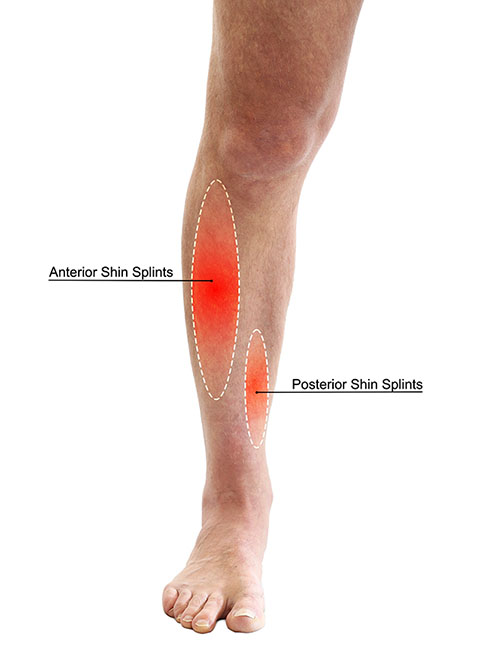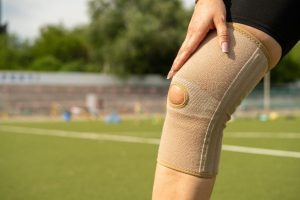You don’t need to be a runner to be familiar with the pain and frustration of shin splints. All one needs to do is take up any activity where we’re repeatedly hitting our feet on hard surfaces – running, field sports, hiking, and even walking can lead to shin splints.
Shin splints (medial tibial stress syndrome) are a condition that results in pain and inflammation in the lower legs, specifically along the shinbone (tibia). Shin splints often happen as a result of overuse or repetitive stress on the lower leg muscles and bones. This can occur from activities like running, jumping, or dancing. If you have shin splints, you may feel pain along the inside or outside of your shinbone. The pain may be dull or sharp, and it may get worse with activity.
Though shin splints are a common sports injury among newer runners / hikers, they can sideline even the most dedicated runners, and they are a common reason that athletes seek physical therapy.
But what are they, exactly? And more importantly, how can you fix them and prevent them from happening in the future? Read on to find out.
What are shin splints and what causes them?
Many of us don’t think twice after getting a little bit of pain from a hike, run, or bout of exercise. However, it’s important to monitor this pain so it doesn’t develop into a full-blown condition. There are two primary types of shin splints, and it’s important to know which one you have:
Anterior shin splints
This type of shin splint is caused by irritation to the tibialis anterior, a muscle responsible for lifting the foot up. It presents as pain along the front of the shin, right next to the bone.
Posterior shin splints
This type of shin splint is caused by irritation of the tibialis posterior, a muscle that lowers the foot and points the toes. This type of shin splint presents as pain along the back of the tibia (shin bone).
Symptoms of shin splints
Both types of shin splints often start as a dull ache that the athlete will often interpret as pain in the bone. It is common for a dull ache to turn into full-blown pain very quickly. Symptoms can sometimes also include slight swelling, pain at the beginning exercise (during a warm-up), or pain that suddenly worsens during exercise. Certain motions, such as pointing the toes, can also trigger the pain.

We recommend that if you have these shin splint symptoms, you begin to treat them as soon as possible. If left untreated, they can turn into a muscle detachment or a stress fracture, sidelining the athlete for months at a time.
Causes of shin splints
Shin splints are typically caused by overuse of the muscle during high impact activities (running, sports, or hiking). This is why we often hear of shin splints early in a track, soccer, or basketball season, for instance. When an individual hasn’t run or walked much for a while, and then they suddenly start, shin splints often develop. They can even be accompanied by other injuries, such as runner’s knee or plantar fasciitis.
In more experienced athletes, shin splints can develop from a sudden increase in intensity. For instance, if a runner suddenly goes from running 10 miles per week to 20 miles per week, or a runner who typically runs 8:00 miles suddenly starts running 6:30 miles regularly.
This can also occur in non-runners, such as when an individual takes up hiking or begins training for their dream hike.
Whatever the activity, we know that shin splints are almost always caused by these sudden increases in volume or intensity, and they can be avoided by following a slow and systematic approach to increasing volume over time.
How to fix shin splints?
The good news is that there are a number of things you can do to treat shin splints and get back to your favorite activities.
Rest
One of the most important things you can do for shin splints is to give your body a chance to recover. Avoid any activities that aggravate your pain, and take a few days off from exercise if possible. As noted above, the injury tends to compound over time. It’s better to deal with a couple weeks of rest than a couple months of pain.
Ice
Applying ice to the affected area can help reduce inflammation and pain. Try ice for 15-20 minutes at a time, several times a day.
Stretch
Stretching the muscles in your lower leg can also help relieve pain and improve flexibility. In a future article, we will cover some stretches for shin splints.
Strengthen
Once the pain from shin splints has subsided, you can begin to focus on strengthening the muscles in your lower leg. This will help support your shins and prevent further injury. We will similarly cover some strengthening exercises for shin splints in a future article.
Massage
Massaging the muscles in your lower leg can also help reduce pain and inflammation. Try using a foam roller or tennis ball to massage the affected area.
See a doctor
If home treatment doesn’t seem to be helping, or if you’re experiencing severe pain, it’s time to see a doctor. They can help you diagnose the problem and develop a treatment plan.
Prevention tips for shin splints
Warm up before exercise
Be sure to warm up before any activity that may put stress on your shins. A good warm-up will help increase blood flow to the muscles and prepare them for activity.
Wear proper shoes
Wearing shoes that fit well and provide support can help prevent shin splints. If you’re a runner, be sure to replace your shoes every 300-500 miles.
Increase mileage slowly
If you’re just starting a running program, be sure to increase your mileage slowly. This will help your body adjust to the new activity and reduce the risk of injury.
Cross-train
In addition to running, be sure to include other activities in your workout routine. This will help reduce the risk of overuse injuries like shin splints.
FAQs about shin splints
Here are some common questions and answers that we get about shin splints in our practice:
The most common symptom of shin splints is pain along the shinbone. The pain may be dull or sharp, and it may worsen with activity. Other symptoms may include inflammation, tenderness, and muscle weakness.
The length of time it takes to recover from shin splints depends on the severity of the medical condition. For most people, rest and home treatment are enough to relieve symptoms within a few weeks.
Yes, there are a number of things you can do to prevent shin splints. These include warming up before exercise, wearing proper shoes, and increasing mileage slowly. Additionally, cross-training and including other activities in your workout routine can help reduce the risk of shin splints.
If home treatment doesn’t seem to be helping, or if you’re experiencing severe pain, it’s time to see a doctor. They can help you diagnose the problem and develop a treatment plan.
The outlook for shin splints is generally good. Most people are able to treat their symptoms at home and make a full recovery within a few weeks. However, severe cases may require more aggressive treatment, such as physical therapy or surgery.
If you’re experiencing shin pain, be sure to take some time off from exercise and give your body a chance to recover. Additionally, ice the affected area and stretch the muscles in your lower leg. You can also begin to focus on strengthening the muscles in your lower leg. Finally, see a doctor if home treatment doesn’t seem to be helping. With proper treatment, most people are able to make a full recovery from shin splints.

















